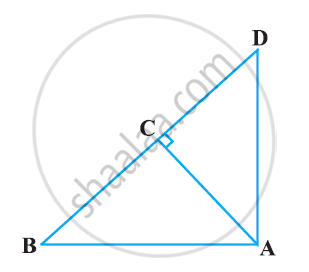Advertisements
Advertisements
Question
In Figure, ABD is a triangle right angled at A and AC ⊥ BD. Show that AD2 = BD × CD

Solution
In ΔDCA and ΔDAB, we have
∠DCA = ∠DAB (Each equals to 90°)
∠CDA = ∠ADB (common angle)
∴ ΔDCA ~ ΔDAB [By AA similarity criterion]
`⇒ (DC)/(DA) = (DA)/(DA)`
⇒ AD2 = BD × CD
APPEARS IN
RELATED QUESTIONS
If the sides of a triangle are 6 cm, 8 cm and 10 cm, respectively, then determine whether the triangle is a right angle triangle or not.
An aeroplane leaves an airport and flies due north at a speed of 1,000 km per hour. At the same time, another aeroplane leaves the same airport and flies due west at a speed of 1,200 km per hour. How far apart will be the two planes after `1 1/2` hours?
Digonals of parallelogram WXYZ intersect at point O. If OY =5, find WY.
If P and Q are the points on side CA and CB respectively of ΔABC, right angled at C, prove that (AQ2 + BP2) = (AB2 + PQ2)
The sides of the triangle are given below. Find out which one is the right-angled triangle?
8, 15, 17
The sides of the triangle are given below. Find out which one is the right-angled triangle?
11, 60, 61
In a triangle ABC, AC > AB, D is the midpoint BC, and AE ⊥ BC. Prove that: AB2 + AC2 = 2(AD2 + CD2)
In a right-angled triangle ABC,ABC = 90°, AC = 10 cm, BC = 6 cm and BC produced to D such CD = 9 cm. Find the length of AD.
In a square PQRS of side 5 cm, A, B, C and D are points on sides PQ, QR, RS and SP respectively such as PA = PD = RB = RC = 2 cm. Prove that ABCD is a rectangle. Also, find the area and perimeter of the rectangle.
If in a ΔPQR, PR2 = PQ2 + QR2, then the right angle of ∆PQR is at the vertex ________
